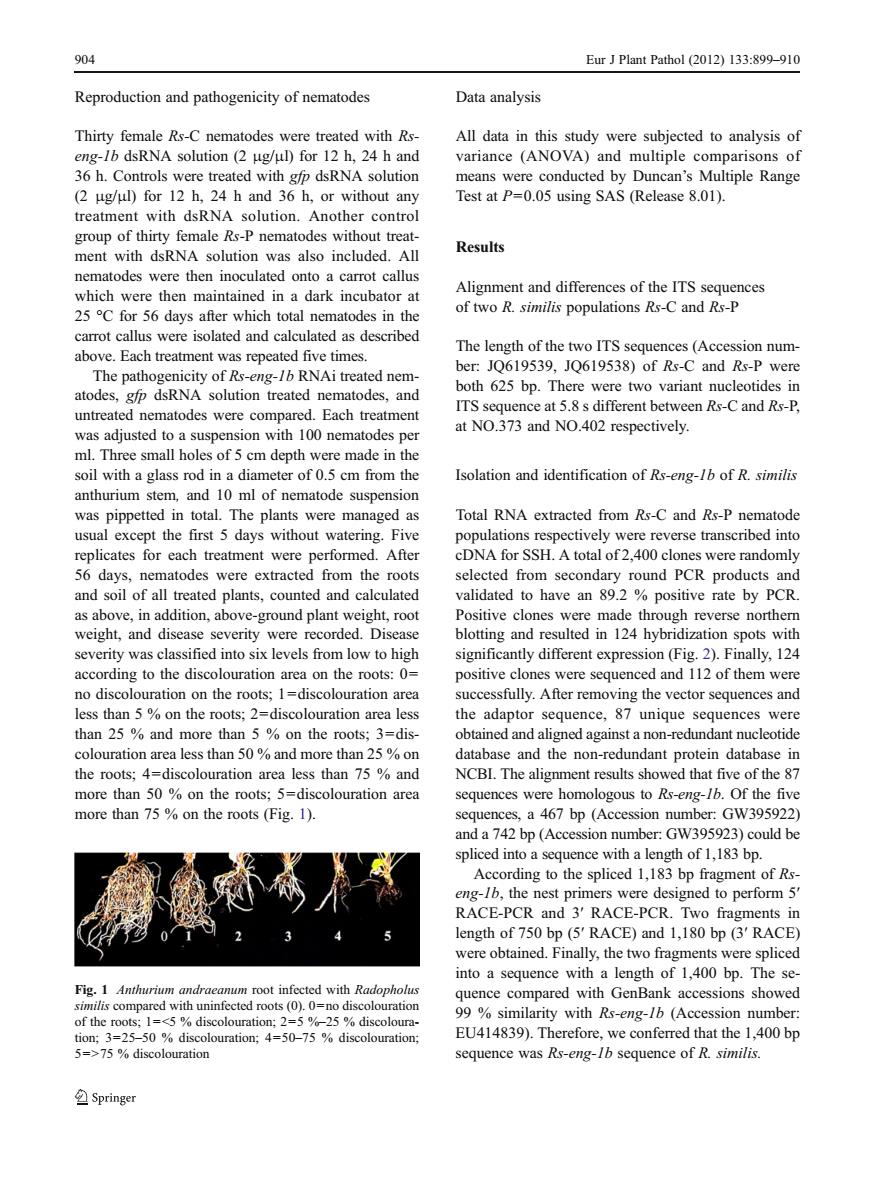正在加载图片...

904 Eur I Plant Pathol (2012)133:899-910 Reproduction and pathogenicity of nematodes Data analysis Thirty female Rs-C nematodes were treated with Rs- All data in this study were subjected to analysis of eng-Ib dsRNA solution (2 ug/ul)for 12 h,24 h and variance (ANOVA)and multiple comparisons of 36 h.Controls were treated with gp dsRNA solution means were conducted by Duncan's Multiple Range (2 ug/ul)for 12 h,24 h and 36 h,or without any Test at P=0.05 using SAS (Release 8.01). treatment with dsRNA solution.Another control group of thirty female Rs-P nematodes without treat ment with dsRNA solution was also included. Results nematodes were then inoculated onto a carrot callus which were then maintained in a dark incubator Alignment and differences of the ITS sequences of two R.similis populations Rs-C and Rs-P 25 C for 56 days after which total nematodes in the carrot callus were isolated and calculated as described above.Each treatment was repeated five times The length of the two ITS sequences(Accession num- ber:JQ619539,JQ619538)of Rs-C and Rs-P were d nem atodes. both 625 bp.There were two variant nucleotides in ITS sequence at 5.8s different between Rs-C and Rs-P, at NO.373 and NO.402 respectively. solation and identification of Rs-eng-1b of R.similis Total RNA extrac d from Rs-C and Rs-P A to I of 2 P d ar ully g the ve that A6 uld b 1183h d1.183bp 4 of 750 bp (5'RACE)and 1,180 bp (3'RACE) ad Finally the t ngth of 1 400 hn The Fig.1 Anthurium andrae num root infected with Radopholu with genBank a of the ity with Rs ng-1b (Acc ouration:4=50-75 discolouration EU414839).The d that the 1 400 br dis vas Rs. eng-16 of R sin SpringerReproduction and pathogenicity of nematodes Thirty female Rs-C nematodes were treated with Rseng-1b dsRNA solution (2 μg/μl) for 12 h, 24 h and 36 h. Controls were treated with gfp dsRNA solution (2 μg/μl) for 12 h, 24 h and 36 h, or without any treatment with dsRNA solution. Another control group of thirty female Rs-P nematodes without treatment with dsRNA solution was also included. All nematodes were then inoculated onto a carrot callus which were then maintained in a dark incubator at 25 °C for 56 days after which total nematodes in the carrot callus were isolated and calculated as described above. Each treatment was repeated five times. The pathogenicity of Rs-eng-1b RNAi treated nematodes, gfp dsRNA solution treated nematodes, and untreated nematodes were compared. Each treatment was adjusted to a suspension with 100 nematodes per ml. Three small holes of 5 cm depth were made in the soil with a glass rod in a diameter of 0.5 cm from the anthurium stem, and 10 ml of nematode suspension was pippetted in total. The plants were managed as usual except the first 5 days without watering. Five replicates for each treatment were performed. After 56 days, nematodes were extracted from the roots and soil of all treated plants, counted and calculated as above, in addition, above-ground plant weight, root weight, and disease severity were recorded. Disease severity was classified into six levels from low to high according to the discolouration area on the roots: 00 no discolouration on the roots; 10discolouration area less than 5 % on the roots; 20discolouration area less than 25 % and more than 5 % on the roots; 30discolouration area less than 50 % and more than 25 % on the roots; 40discolouration area less than 75 % and more than 50 % on the roots; 50discolouration area more than 75 % on the roots (Fig. 1). Data analysis All data in this study were subjected to analysis of variance (ANOVA) and multiple comparisons of means were conducted by Duncan’s Multiple Range Test at P00.05 using SAS (Release 8.01). Results Alignment and differences of the ITS sequences of two R. similis populations Rs-C and Rs-P The length of the two ITS sequences (Accession number: JQ619539, JQ619538) of Rs-C and Rs-P were both 625 bp. There were two variant nucleotides in ITS sequence at 5.8 s different between Rs-C and Rs-P, at NO.373 and NO.402 respectively. Isolation and identification of Rs-eng-1b of R. similis Total RNA extracted from Rs-C and Rs-P nematode populations respectively were reverse transcribed into cDNA for SSH. A total of 2,400 clones were randomly selected from secondary round PCR products and validated to have an 89.2 % positive rate by PCR. Positive clones were made through reverse northern blotting and resulted in 124 hybridization spots with significantly different expression (Fig. 2). Finally, 124 positive clones were sequenced and 112 of them were successfully. After removing the vector sequences and the adaptor sequence, 87 unique sequences were obtained and aligned against a non-redundant nucleotide database and the non-redundant protein database in NCBI. The alignment results showed that five of the 87 sequences were homologous to Rs-eng-1b. Of the five sequences, a 467 bp (Accession number: GW395922) and a 742 bp (Accession number: GW395923) could be spliced into a sequence with a length of 1,183 bp. According to the spliced 1,183 bp fragment of Rseng-1b, the nest primers were designed to perform 5′ RACE-PCR and 3′ RACE-PCR. Two fragments in length of 750 bp (5′ RACE) and 1,180 bp (3′ RACE) were obtained. Finally, the two fragments were spliced into a sequence with a length of 1,400 bp. The sequence compared with GenBank accessions showed 99 % similarity with Rs-eng-1b (Accession number: EU414839). Therefore, we conferred that the 1,400 bp sequence was Rs-eng-1b sequence of R. similis. Fig. 1 Anthurium andraeanum root infected with Radopholus similis compared with uninfected roots (0). 00no discolouration of the roots; 10<5 % discolouration; 205 %–25 % discolouration; 3025–50 % discolouration; 4050–75 % discolouration; 50>75 % discolouration 904 Eur J Plant Pathol (2012) 133:899–910